News Items April 2012
 Click logo to return to 'links-page'
Click logo to return to 'links-page'

In discussion the following points were made.
- At the present rate of increase in the volume of atmospheric greenhouse gases, change could indeed be very rapid. We should be as concerned about how to adapt to the consequences as about how to mitigate them. Humans were now set on a suicidal course.
- One way of looking at the ethical issues involved, was the philosophy of Contraction and Convergence (as expounded by Aubrey Meyer). We faced a moral as well as a scientific problem and the long term future required a reduction in current inequities.
- The consumer model of society, as understood in the West, was unsustainable, and unless corrected would lead to social and economic collapse. New applications of technology might solve some problems but create others.
- We had to look again at the use of fiscal instruments as a means of giving incentives for different behaviour, and imposing penalties on those who did not conform. Life styles in the West had to change if anything like a more equitable world was to be created. There was a moral imperative behind the need for change.
- It might be necessary to give people a fright before they saw sense. According to the doctrine of benign catastrophes, we needed things to go visibly and accountably wrong to create the right mood for change. We had to hope that they would be more benign than catastrophic. A good example was hurricane Katrina, but it had to be correctly interpreted. One way of looking at this issue was to see it in terms of security. This would help move it up national as well as global agendas.
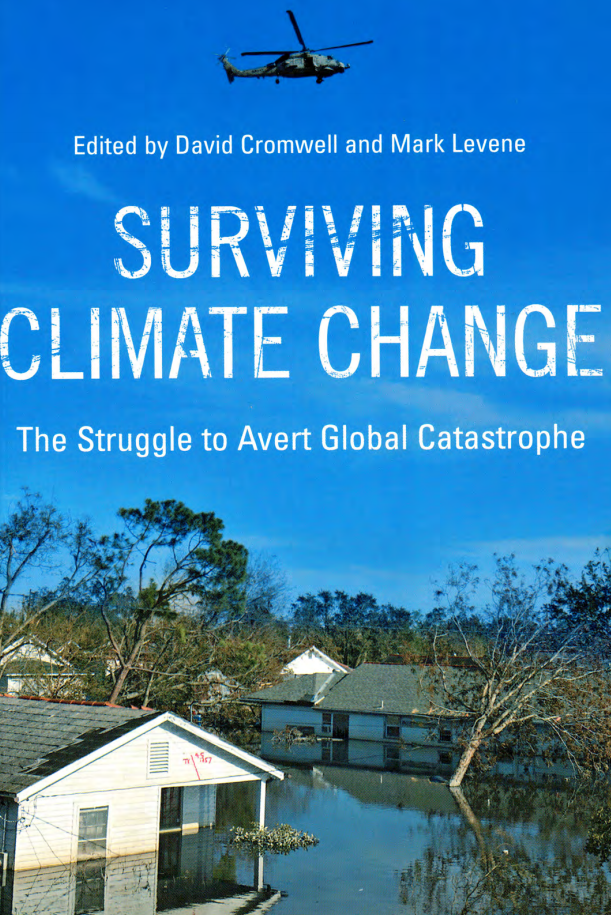
"Climate change is a pressing reality. From hurricane Katrina to melting polar ice, and from mass extinctions to increased threats to food and water security, the link between corporate globalization and planetary blowback is becoming all too evident. Governments and business keep reassuring the public they are going to fix the problem. An epochal change is called for in the way we all engage with the climate crisis. Key to that change is Aubrey Meyer's proposed "Contraction and Convergence" framework for limiting global carbon emissions, which he outlines in this book."
"Surviving Climate Change"
Editors Mark Levene & David Cromwell
Southampton University Crisis Forum

"Bjørn Lomborg, for example, suggests that extending the terms of Kyoto throughout the century would mean that the world would have to wait one year to enjoy the economic prosperity it would have enjoyed in 2050 if no international action to combat climate change had been undertaken."
Rival architectures can usefully be analysed in terms of their fit with four principles of equity: -
- C1: A safe atmosphere: climate architectures (and the measures they involve) should aim to minimise ‘dangerous climate change’. There is no consensus as to what constitutes dangerous climate change, or what level of global warming would trigger it since the idea has an irreducibly normative, as well as natural scientific, component (Schneider and Lane, 2006, p. 7). However, a useful working definition can be found in terms of the aim to limit increases in atmospheric concentrations of CO2 to a doubling of their pre-industrial level of 280 parts per million (ppm). For comparison, atmospheric CO2 concentrations reached 377 ppm in 2004 – a 35 per cent increase on the pre-industrial level (Keeling and Whorf, 2005).
- C2: Affordability: climate architectures should not be excessively costly to adopt for existing and subsequent generations. This is a complex issue, given that estimating the social and economic impacts of alternative climate responses rests not only on accurate models of climate change for different levels of CO2, but also of development, population growth and migration (Tol, 2002, pp. 48ff.).
- P1: Universal participation: members of all countries should be represented in the construction of the climate architecture and its mechanisms and policies; and while future generations cannot participate directly, their interests should also be taken into consideration at all times.
- P2: Fair burden sharing: the costs of implementing the architectures and the measures they involve should reflect the differing contributions of each country (and its members) to present and future climate change as measured by their current and historical greenhouse emissions.
‘Contraction and Convergence’, has three main components.
- Each person on the planet is granted an ‘equal right to emit’ greenhouse gases by virtue of their equal right to use the benefits provided by a shared atmosphere. This principle is treated as intrinsic to the architecture of the approach.
- A ‘global ceiling’ for greenhouse emissions is set based on a calculation of the amount the atmosphere can withstand without dangerous climate changes emerging.
- Each country is allocated a yearly ‘carbon emissions budget’ consistent with the global ceiling not being exceeded, and calculated according to each country’s population size relative to an agreed base year.
The key aim is to bring about a stabilisation, and later a contraction, in global greenhouse emissions so that they stay below a safe level, together with the idea that, in the longer term, all countries will converge on a roughly equal level of per capita emissions compatible with the long-term stability of the climate system. Within this approach, a country that wants to emit more than its yearly quota must buy credits from countries that have spare capacity. The country selling the credits can then invest the receipts in activities enabling it to develop in a sustainable manner. The flexibility of this approach means that many developing countries will not be required to reduce their emissions to the same extent as developed countries even though there will be a cap on how much their emissions are permitted to grow. While ‘emissions trading’ is a key feature of all of the proposed successors to Kyoto, the trading zone under Contraction and Convergence covers the whole planet from the outset.
Unlike a number of competing approaches, Contraction and Convergence, if fully implemented, could be expected to reduce the risks of dangerous climate change substantially. Although the approach would be more costly to implement than its rivals in the short to medium term, it sits more easily with principles C1 and C2 than its rivals when we focus on the longer term. It also has the merit that, because it adopts emissions targets based on scientific criteria for protecting the atmosphere it reduces the role of power politics in determining the structure of the regime. The approach still involves a certain amount of horse trading associated with the selection of the base year (as well as with the specific details of mechanisms concerned with emissions trading and the role of sinks) but much less than with rival architectures. Moreover, the ‘convergence’ part of Contraction and Convergence at least partly deals with the need to achieve a fairer international distribu tion of the benefits associated with CO2 emissions. For all these reasons, this architecture seems to fit better with principle P2 than its rivals.
Finally, Contraction and Convergence also offers an interesting approach to the problem of historical responsibility, which has hitherto dogged attempts to construct a truly global solution to climate change for some developed countries (principle P1). Contraction and Convergence, in being a fundamentally forwardlooking approach to climate change, does not allocate the most costly duties of climate mitigation and adaptation to developed countries because they are responsible for the emergence of climate change. Rather, it distributes the duties of climate management in line with their ability to undertake the protective measures deemed necessary to safeguard a future where dangerous climate change is avoided. As a result, Contraction and Convergence may prove more attractive, and therefore motivational, than rival architectures that appeal to the controversial historical duties members of developed countries possess as a result of the behaviour of their ancestors.
EQUITY AND THE KYOTO PROTOCOL Edward Page Journal compilation
Political Studies Association POLITICS: 2007 VOL 27(1)
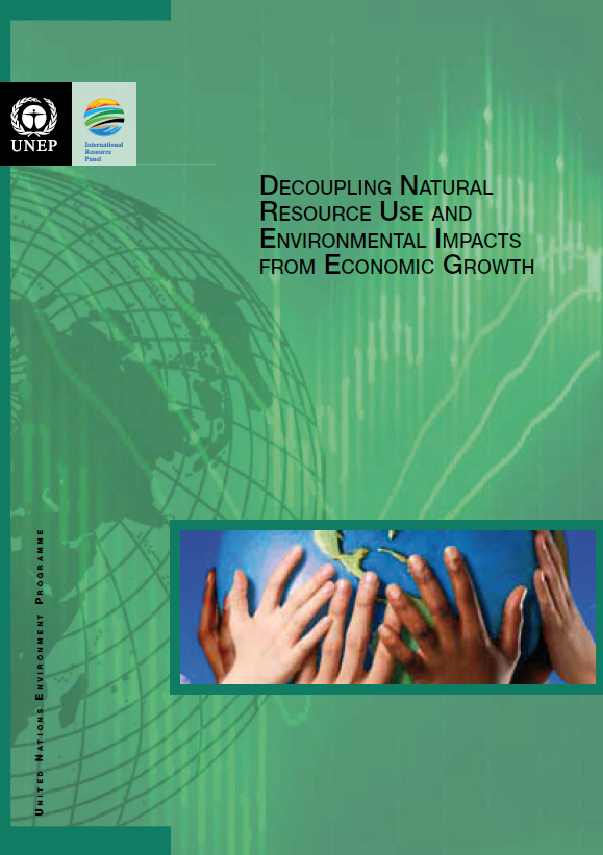
Having reviewed the trends in the use of natural resources and accompanying undesirable environmental impacts in the first section of Chapter 2, the last section of that chapter considers possible future implications by presenting three brief scenarios:
- business as usual (leading to a tripling of global annual resource extraction by 2050);
- moderate contraction and convergence (requiring industrialized countries to reduce their per capita resource consumption by half the rate for the year 2000); and
- tough contraction and convergence (aimed at keeping global resource extraction at its current levels).
None of these scenarios will lead to actual global reductions in resource use, but all indicate that substantial reductions in the resource requirements of economic activities will be necessary if the growing world population can expect to live under conditions of sustainable resource management. The key message of the tough scenario is that despite population growth to roughly 9 billion people, the pressure on the environment would remain roughly the same as it is now.
The emissions correspond approximately to the lowest range of scenario B1 of the IPCC SRES, but are still 20% above the roughly 5.5 GtC/yr advocated by the Global Commons Institute for contraction and convergence in emissions (GCI, 2003).
UNEP - 2011: Decoupling Natrual Resource Use & Environmental Impacts from Economic Growth
Dr Ernst von Weizsacker, Dr Ashok Khosla, Co-Chairs International Resource Panel

Contraction and convergence
The contraction-and-convergence approach assigns every human being an equal entitlement to greenhouse gas emissions. All countries would thus move toward the same per capita emissions. Total emissions would contract over time, and per capita emissions would converge on a single figure. The actual convergence value, the path toward convergence, and the time when it is to be reached would all be negotiable. [Meyer].
World Bank Development Report 2010
Development and Climate Change

Contraction and Convergence [C&C]. This plan combines equal rights to emit with grandfathering [or assigning rights based on past emissions, the higher the past emissions, the larger the grandfathered emissions rights]. Each country is allocated emissions right based on its past emissions. Countries that exceed desired per capita global emissions have their allocation reduced in each succeeding year, while countries that emit less that this target receive a higher allocation each year. Over time global emissions contract while high an low emitting countries converge on the same per capita emissions [Global Commons Institute].
World Economic and Social Survey 2009, Promoting Development Saving the Planet
UN Department of Economic and Social Affairs

ZIMBABWE: [for the Africa Group]
“ . . . . . we do support the amendment that is poposed by the distinguished delegation from India, and just to emphasise the point of the issues that still need a lot of clarification would like to propose in that paragraph the inclusion, ater “entitlements” that is the proposal by the delegation of India, the following wording; ater “entitlements, the global ceiling date and time for contraction and convergence of global emissions because we do think that you cannot talk about trading if there are not entitlements, also there is a question of contraction and convergence of global emissions that comes into play when you talk about the issue of equity . . . . . “
CHAIRMAN Raul Estrada
"I thank you very much. May I ask again the distinguished delegate of the USA if they have another suggestion to propose in connection with the proposals made by the distinguished delegate of India. He does."
UNITED STATES OF AMERICA
“ . . . . It does seem to us that the proposals by for example India and perhaps by others who speak to Contraction and Convergence are elements for the future, elements perhaps for a next agreement that we may ultimately all seek to engage in."
- There must be limits on all GHGs if the danger to our climate is to be averted. The IPCC scientific assessment report provides us with the basis for global consensus on such limits. The contrary view therefore does not enjoy much emotional, political or indeed scientific support.
- A globally agreed ceiling of GHG emissions can only be achieved by adopting the principle of per capita emissions rights that fully take into account the reality of population growth and the principle of differentiation.
- Achievement of a safe limit to global GHG emissions can be achieved by reducing the emissions of Annex One while at the same time ensuring that there is controlled growth of future emissions from Non-Annex One countries, reflecting our legitimate right to sustainable economic growth.We strongly believe that this will take us along a path to responsible climate management that allows us to reach our goal of defining a mutually agreed point of convergence and sustainable development. Such a convergence Mr. Chairman must ensure that we maintain a global ceiling on emissions to prevent dangerous interference with the climate system.
- When we look at time frames, we believe that insufficient commitment by Annex One countries will only result in delaying our influence on the climate system. If this course is maintained, then we will all suffer and the burden will be even greater for humanity in general. The burden for any future mitigation efforts on those of who have not been historically and currently responsible for creating the problem will be greater.
Africa Group of Nations Position Statement
to the UN climate negotiations, August 1997 AGBM

It is more equitable and fair to consider the per capita emission concept and data. This is because some countries have large total emissions mainly because of their huge population sizes, and not because of the emission intensity. The principle of “contraction and convergence” would be equitable and thus more capable of winning support by more people. In this principle, the world as a whole has to contract or reduce its total emissions. In doing so, an equitable principle is used. Take the total maximum emission level that is sustainable, i.e. that the world is able environmentally to sustain. Divide this total by the world’s population. That level of emission per capita could be considered the “emission right” or “emission entitlement” per person.
Martin Khor - Director Third World Network - August 2007
To the Special UN General Assembly Session on Climate Change

Key Recommendations
In light of the growing human impact of climate change and the pressures of this crisis for humanitarian and development work, the following is a list of key recommendations made by the different discussion groups at the 2009 Forum.
Climate vulnerable coalition
Those nations most vulnerable to the impacts of climate change should form a common front in order to increase awareness on the impact and risks of climate change, share expertise relating to climate change policy, and influence the development of safe and equitable international climate change policy, in particular with the strongest possible impact on the 2009 UN Climate Conference at Copenhagen
Future international climate change agreement
1. The principle of contraction and convergence with a population base year should provide the basis framework for global greenhouse gas emission reductions
2. “No deal is better than a bad deal”: it would be more constructive to avoid conclusion at the 2009 UN Climate Conference at Copenhagen of any climate change agreement that would not provide for basic levels of safety, equity and predictability
3. All parts of civil society should make a concerted attempt to create wide multi-stakeholder partnerships for concentrating pressure for a successful conclusion to the Bali Road Map and the Copenhagen Conference."
2009 Global Humanitarian Forum
Human Impact of Climate Change

Contraction and Convergence model provides one transparent solution with equal per capita emissions for the mitigation of COs emissions The model requires considerable emissions reductions which, according to our study, seem to be possible when the changes arc analyzed from the point of view of emissions intensity development. According to the Fourth Assessment Report of the IPCC a considerable reduction of greenhouse gas (GHG) emissions is required in order to prevent dangerous anthropogenic interference with the climate system. Various different approaches have been proposed to allocate commitments regarding the future greenhouse gas emission mitigation for different countries. One of them is the Contraction and Convergence (C&C) model of future GHG emissions (GCI. 2003). The C&C approach defines emission permits on the basis of converging national GHG emission rates to an equal level which is based on per capita emissions under a contracting global emission profile. In this study we have used a target of 1.8 tons of CO2 per capita. which should be achieved by all countries by a designated year, 2040. This satisfies the requirement set by IPCC to reduce the total emissions by 50 to 85% from the 2000 level in order to limit the global temperature increase to 2-2.4°C. The purpose of this paper is to analyze what the C&C approach might mean for the examined countries and to analyze the potential changes that are needed in the emission intensities of the selected countries in order to achieve their C&C targets. For further information on the data and methodology used in this study please see GCI (1998, 2003). (IEA (2003 a. b. e) and (UN 2003) for data sources and Luukkanen et al. (2005) for methodology.
Sustainable Energy Production and Consumption - Frano Barbir Sergio Uliati
NATO Science for Peace and Security Programme

Some proposals compensate the potential burden on developing nations with generous emissions allocation, whether as a simple strategy to obtain developing countries support for the regime or in a realisation of the global equity principle borrowed from social justice. A famous such proposal is “Contraction and Convergence” developed by Aubrey Meyer.
Act Locally Trade Globally - Emissions Trading for Climate Policy
Organisation for Economic Cooperation and Development OECD & IEA

A number of principled proposals have been advanced to help address the enormously complex political question including the Contraction and Convergence approach of GCI. In such proposals emissions are normally calculated on a per capita basis to draw attention to the underlying inequities in historical and current patterns of global consumption.
The Social Dimensions of Climate Change
Robert Mearns and Andrew Morton - World Bank
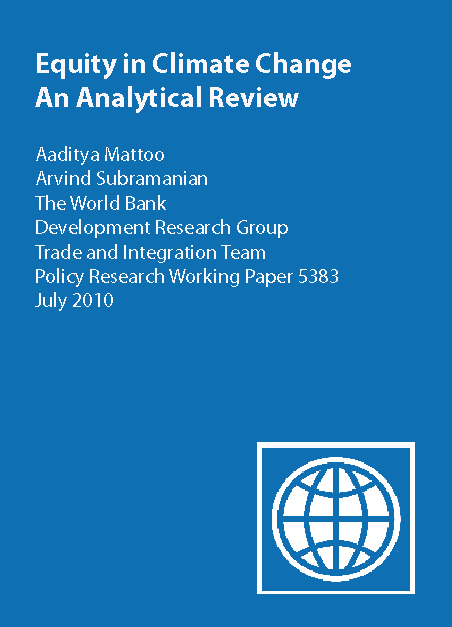
It is worth noting that the Stern (2007) and UNDP (2008) proposals are very close in spirit to the “contraction and convergence” ideas first proposed by Meyer (2000), which involves the global carbon budget contracting consistent with climate change goals, with rich countries converging down, and poor countries converging up, to a common emissions per capita target in the long run.
Equity in Climate Change An Analytical Review
Aaditya Mattoo Arvind Subramanian
The World Bank Development Research Group
Trade and Integration Team Policy Research Working Paper 5383 July 2010
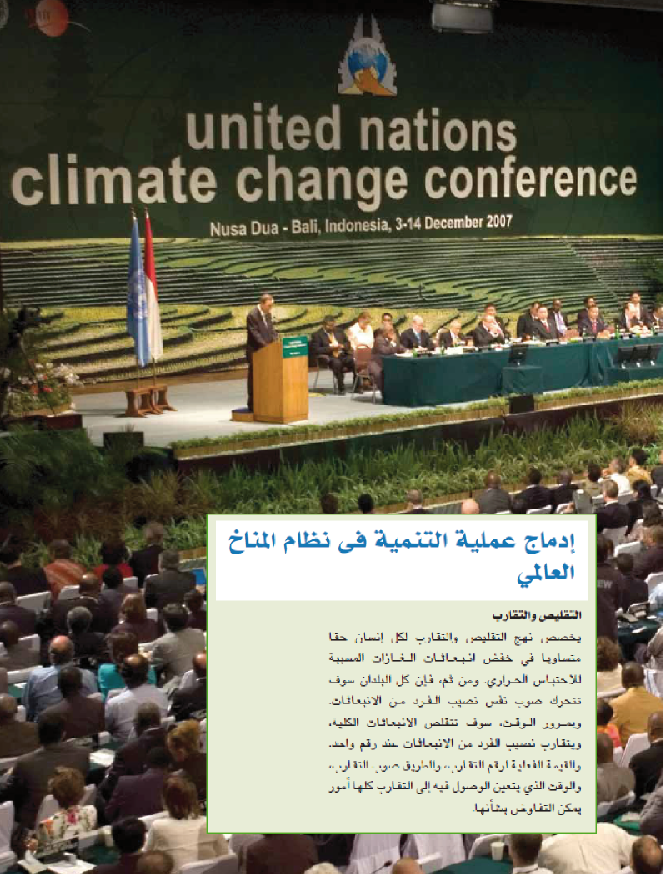
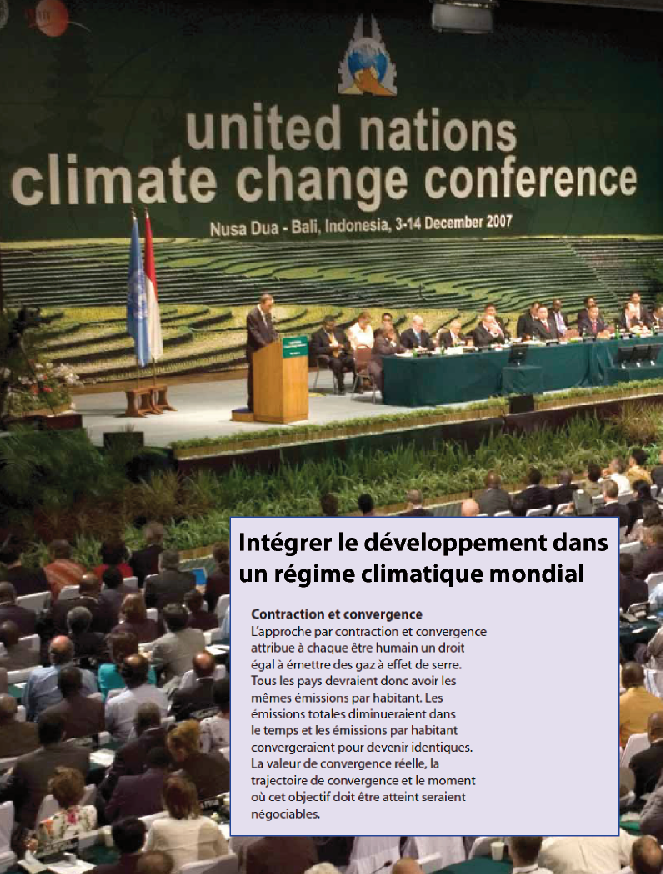
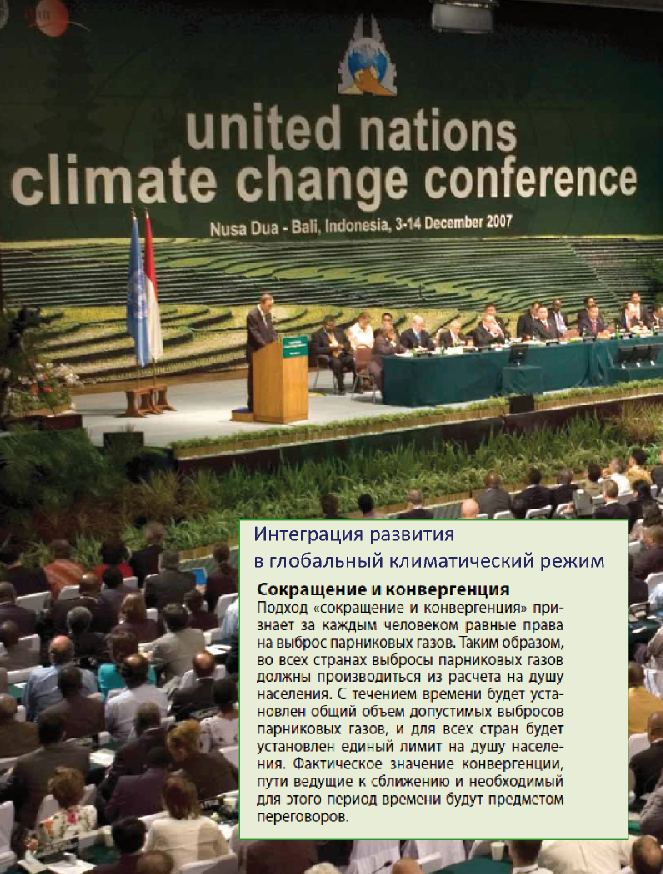
Contraction and convergence
The contraction-and-convergence approach assigns every human being an equal entitlement to greenhouse gas emissions. All countries would thus move toward the same per capita emissions. Total emissions would contract over time, and per capita emissions would converge on a single figure. The actual convergence value, the path toward convergence, and the time when it is to be reached would all be negotiable.
World Bank Integrating Development into the Global Climate Regime

Article on C&C and C1, C2, C3 scenarios in Climate Action
"Technically, the C&C model is a coherent and mathematically-stable framework. It holds the science policy content together as a unity, science-based on the contraction side of the argument and rights-based or 'constitutional on the 'political' side of the argument. C&C is in effect a bill of rights, It simply plots a full-term event for achieving equal per capita emissions rights globally [Convergence] but governed by the overall emissions limit over time that stabilises the atmosphere concentration of GHG at a 'safe' value [Contraction]. The UNFCCC makes C&C generically true, but C&C specifically embraces a calculus built on this truth."

Core Objectives - Climate change as an environmental hazard:
explain how climate change impacts on health inequalities and the wider determinants of health
a) Outline the effects of climate change on health:
b) Describe the impact of climate change on health inequalities:
c) Discuss ethical issues over distributive justice in carbon reduction
- Mechanisms by which climate change affects the wider determinants of health
- Disease processes affected by climate change
- Examples of health effects that have already been observed
- Examples of projected health effects – in developing countries and in the UK
- The exacerbation of inequalities through the impact of climate change
- The role of inequalities in causing climate change
- The theory of contraction and convergence
Climate Change and the Determinants of Health in Medical Schools
Learning Objectives Centre for Sustainable Health Care
Partners include: -
- The NHS Sustainable Development Unit
- The Climate and Health Council
- The Medical Fair and Ethical Trade Group of the BMA
- The Carbon Trust
- The Carbon Disclosure Project
- The Sustainable Development Commission
- Good Corporate Citizenship Assessment Model
- Cornwall and Isles of Scilly PCT
- The UK Public Health Association
- South East Coast Strategic Health Authority
- South Central Strategic Health Authority
- The Renal Association
- British Renal Society
- NHS Kidney Care
- UK National Kidney Federation
- 10:10 Campaign
- 2degrees
- Medact
- Medsin/Healthy Planet

CONTRACTION & CONVERGENCE:
The Contraction part concentrates on the total amount of Carbon being put into the atmosphere. This lays down an annual fall of global emissions - how great that fall would be would depend on the final level of atmospheric carbon considered safe.
The Convergence part lays down how the entitlements to emit carbon are distributed between the countries of the world. Initially these entitlements would reflect current emissions to reflect the difficulty in making the transition. However these initial entitlements will converge towards equal per capita emissions across the planet. The year when entitlements reach equality would be subject to negotiation. Once Convergence has been reached then all countries entitlements would continue to fall, that is to say contract.
Contraction & Convergence is the underlying international approach H35O - along with most others - support. In a sense Holyrood 350 is advocating unilateral Contraction and Convergence within Scotland in order to show that this is possible and inspire others to follow our example.

Contraction & Convergence or 'C&C'
Minimising manmade climate change is almost certainly the biggest challenge faced by humans. Some impacts are happening right now (often in parts of the world least equipped to deal with them) because of greenhouse gases already released into the atmosphere. We have to act quickly and decisively to avoid really dangerous climate effects.
Developed by Aubrey Meyer of the Global Commons Institute, the Contraction and Convergence (C&C) model is a widely accepted global framework for reducing greenhouse gas emissions (GHGs) to safe levels in a socially just way. The model provides a global ‘carbon budget’ with annual reduction targets for CO2 emissions, based on levels considered safe to avert dangerous climate change. Once in the atmosphere, GHGs can take up to 200 years to decay, so to stay within safe levels we'll have to continue to reduce, or ‘contract’ emissions year-on-year, to near zero by around 2080.
Global equity is a governing principle of the C&C model. Historically, levels of emissions have been related to a nation’s wealth. As a result, per capita emissions (‘per person’ averages) in rich countries are well above the global average and in poor countries, well below. In the C&C Framework everyone is given an equal right to emit CO2. In order to resolve current inequalities, individuals in developing countries would initially be entitled to emit relatively more CO2, and those in developed nations relatively less, until per capita emissions from all countries ‘converge’ at an agreed annually reviewed level.
In applying the C&C model, the UK’s permitted emissions have been divided by its projected population to give a per capita figure. This indicates how much carbon individuals within the UK are entitled to emit, otherwise referred to as our individual ‘carbon budget’ or ‘Fair Share’. For 2011 our individual carbon budget is calculated at 3.67 tonnes of CO2 emissions, falling to 2.87 tonnes by 2017
The C&C model has also been used to work out an overall carbon budget for the UK which again would need to reduce year-on-year.

We have to make is to find new ways of framing the issues, to reclaim as well as declaim a radical vision for the future. Here’s one example of what I mean: in the film The Age of Stupid, about climate change, there’s a short animation sequence that illustrates the idea of ‘contraction and convergence’.
The animation starts by showing the current global distribution of per capita carbon emissions represented as differently sized people: the USA is huge, Europe quite a lot smaller, China smaller still; India is very small and Africa is tiny. The characters then walk forwards along the timeline, the smallest growing a little, the largest shrinking a lot until, at the year 2035, all the characters reach the same size; and then as they walk forwards to 2065 they all shrink at the same rate.
This is a powerful image, not only of carbon reduction but also of global equity, of ecojustice. Let’s reclaim a powerful political word for this: levelling. The Diggers (often referred to as the ‘true levellers’) were the group with this genuinely radical vision. They were part of the same seventeenth century cauldron of religious and political ferment as gave rise to Quakerism and their leader, Gerrard Winstanley, was among London Quakers at certain times of his life. ‘Levelling’ is the Quaker testimony to equality given a political edge.

Naturally, an agreement will have to be found on the issue of reparations for these cuts. “Contraction and convergence” represents one proposed plan that shows an equal level of emissions per capita for all by the end of the century. The attainment of this objective (re-launched recently by German Chancellor Merkel with the idea of 2 tons annually per inhabitant) involves an expressed decrease of emissions by industrialized countries and smaller amounts by those developing nations reaching a peak by 2025-2030, in order to diminish these emissions.
The ENERGY GAME

Contraction & Convergence and Greenhouse Development Rights:
A Critical Comparison Between Two Salient Climate-Ethical Concepts
Taken together, the above suggests that GDRs performs worse against all of the four criteria. In its present form, GDRs is also inappropriate to implement the right to development and to solve the development crisis.
Compared to GDRs, C&C is easier to negotiate and to implement, C&C has a higher potential to lead to a global climate compromise, C&C rests on less contestable ethical foundations, and has a higher potential to stimulate changes in public attitudes and awareness. All in all, C&C is the preferable concept. However, with a view to tackling the climate challenge, C&C should put more emphasis on the fact that in the future for many countries the conventional development path based on increasing economic growth and the consumption of fossil fuels will no longer be feasible.
Climate change largely challenges prevalent international institutional control mechanisms. To overcome the climate crisis, it is therefore the more important to create a global atmosphere of trust as a basis for comprehensive cooperation across social, economic, and cultural divides. The image of a divided world which is in the centre of the GDRs Framework (e.g. Baer et al. 2008:91) may aptly describe reality but it may not show a vision of how to bridge the gap between rich and poor, North and South. C&C, however, evokes the image of a global community in which, under growing pressure, people in poor and rich countries alike act together to bring about a more careful and sustainable management of the atmosphere.
However, a global climate partnership based on C&C will only be achieved once the obligation of rich countries to assist adaptation in poorer countries is duly recognized. This is not a question of charity but a question of justice and fairness.
Katrin Kraus
Graduate Reseach Assistant in Environmental Ethics
Greifswald University

Two models are currently being pitted against one another in the discussion of a fair climate regime: Contraction and Convergence (C&C) and Greenhouse Development Rights (GDR s). The controversy revolves around issues of fairness and feasibility, and the question of how fair is fair enough. Other approaches with the potential to mitigate emissions fairly are not in discussion at present. The debate over these concepts is vital, as having actors who are individually committed to ambitious goals but divided at the conceptual level could prove fatal for climate policy as a whole. The following is an overview in the magazine of the Heirich Boell Foundations of the core elements of both with Katrin Krause and Konrad Ott for C&C and Tilman Santarius for GDRs.
How Fair is fair Enough?
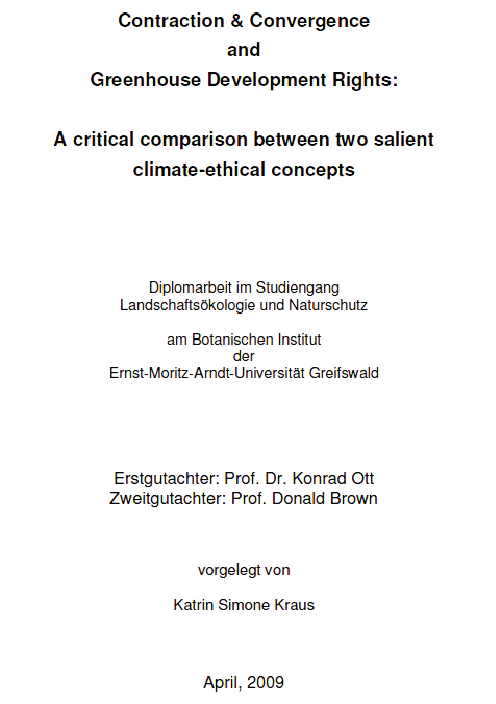
The analysis showed clearly that Contraction and Convergence [C&C] is the preferable concept
with a view to tackling the problem of global greenhouse gas mitigation.
This is not least because it conceptually avoids “business as usual” thinking, planning and forecasting. If implemented, C&C has a higher chance to establish a global atmosphere of trust and to facilitate the building of a more balanced global economic order based on sustainability, creativity, and equity.
Nevertheless, I acknowledge that even if C&C has a higher potential to tackle the climate problem, it may not be able to solve the climate problem as long as it is not supplemented with fundamental reforms to address other grievances, foremost the “human development crisis”.
Although GDRs has been designed with the intention to account for this deficiency, it fails to guarantee
for human development given its exclusive focus on income inequality and its fading out of social realities.
Since some goods and values are incommensurable, GDRs cannot simply be improved by choosing
another indicator for development or well-being.
Contraction & Convergence and Greenhouse Development Rights
A Critical Comparison between two Salient Climate Ethical Concepts
Katrin Simone Kraus 2009
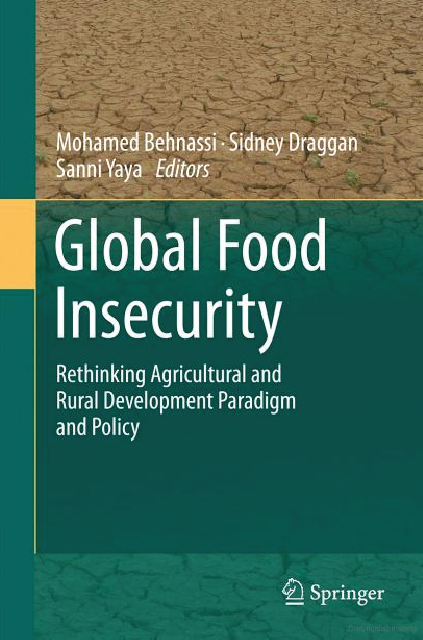
Whilst we can encourage small-scale livestock production for family and local use in poorer nations, those eat high up the food chain surely have a moral oblication to reduce their consumption of animal products. We can eat less so that they can eat more. This theory of contraction and convergence has been outlined by leading public health academics such as Tony McMichael. He and his colleagues believe that those in the developed countries should reduce their meat consumption to no more than 90 gm a day as this would be better for the climate and for their own health (McMichael et al 2007). Those in the developing world could eat more meat until they too reached this level. Even 90 gm a day only helps to stablize and not itself reduce GHG emissions figures.
Global Food Insecurity
Mohamed Behnassi, Sidney Draggan, Sanni Yaya

Poverty Elimination Muhammad Yunus, creator of the Grammeen Bank, says: -
"Poverty is created. Poverty is caused by failure at the conceptual level, rather
than any lack of capability on the part of people. The poor are like bonsai trees,
which possess all the qualities of a larger tree, but are planted in too-small pots."
John Veitch of Open Future New Zealand has maintained a journal of interest for more than 30 years.
Creating a page with the links below, he says: -
"That journal has taught many lessons, but the key idea is this. All real education is self directed and self motivated. More-over it takes a long time even for the most willing student to learn new things that are contrary to the indoctrination that we received in childhood and at school. It takes years and years, firstly to recognize that you've been indoctrinated at all. Then to slowly unpick that misdirection and to replace it with something more worthy."

Gus Speth____________Contraction & Convergence_______Yann Arthus-Bertrand
Environmental Law______Gobal Commons Institute _______Photographer "Home"
The Poor are Disconnected Poverty is caused by a network of disconnection. The causes are complex. Personal poverty probably has roots in family life, in the attitudes and values that the family pass on to their children. These values might be empowering or they may be toxic in the life of the young person who adopts them. If you have attitudes and a lifestyle that makes you stand out in a negative way, you may find it difficult to win acceptance in the mainstream of society. For instance if one lives in the United Kingdom, but strongly carries the values of a small tribal village in Pakistan, one might struggle to find a place in the new society. In the course of a life, one might become isolated from your family or social group for some reason. Perhaps a failure in education, maybe ill health or alcoholism, or a term in prison.
Once you're out of the loop, finding your social path back into a helpful social circle might be very difficult. People who are seen to be active members of a community, normally find a way to earn a living in that community.
Of course there is an argument that most of the influences above are not about personal and family values alone, that there is a systematic process that is intended to produce an underclass, and to reinforce the advantages of the upper class.
Loss of the Common In many societies the basics of life are provided by family lands and by the village common. One measure of your wealth is how seldom you have to depend on a market to live your life. In most places food is cheap and there is quite a lot of free food available. When that is not the case, food at the market can cost more money than people can easily earn. This is worst if water also has to be purchased. If the forest or a large natural common exists people can survive, but this land has today frequently been turned into farmland, and if the farmland fails because of flood, or drought, the consequence of lack of resilience is no food.

In Brazil, where Aubrey and I attended, actually, the first public debate, on the whole issue, where the Brazilian historical proposals were put up and Aubrey argued his point. It was fascinating, that debate, and one of the key people, who had been one of the architects of the Brazilian proposals, at the end said, “actually, it is Contraction
and Convergence that makes better sense; the logic holds better”.
The EU must take the lead. It needs to use its powers and take up the concept of Contraction and Convergence as a possible approach. Key developing countries such as India - perhaps the most key country as the largest democracy in the world and one who has great interest in this concept - has adopted it to mobilise our community or coalition of the willing to act.
Action for a Global Climate Community

A key example is the global policy framework of ‘Contraction and Convergence’ which prioritises – in order – UNFCCC principles of precaution, equity and efficiency, and within which emissions trading may help accelerate the aggregate contraction of greenhouse gas emissions (Meyer 2007). However, because this proposal involves an initial allocation of emissions entitlements on a equal per capita basis (equity) and subjects them in the aggregate to sustained contraction over time (on precautionary grounds), the policy framework offers no support for the argument that economic growth, still less efficiency alone, may serve environmental ends (Wiener 2009). It should be noted that to suggest that market mechanisms, if implemented according to criteria other than efficiency and/or combined with non-market measures, may mitigate environmental harm is not necessarily the same as saying that they could be effective nor, should some prove to be, more effective than rival approaches.
The Allocation Problem Dr Paul Anderson

One Earth submission UN CSD - Questionnaire to Major Groups
Attachment D - Green Economy Vanessa Timmer to: UNCSD2012
- The green economy must contribute to the goals of sustainability. The overarching goal of the green economy should be defined in the context of a fair and socially just economic system that meets the needs of all people within the ecological carrying capacity of the planet.
- The green economy needs to be a new economy, with new models, mindsets and metrics based on a systems approach. Issues such as poverty, climate change, soil erosion, and the loss of biodiversity are emergent properties of unsustainable consumption and production patterns. In order to address the root causes of these symptoms, a holistic—or systems—approach to problem solving is necessary.
- The green economy must be an economy that moves away from the destructive economic expansion paradigm (at least in rich countries where per capita eco-footprints are above sustainable levels) to one that recognizes ecological limits and that enables people to meet their basic needs, along a global framework of ‘contraction and convergence’.
- We must transform the nature of our impact on the world’s ecological systems. This will mean using innovation to shift from linear patterns - that consume resources and produce wastes – to cyclical patterns where our actions contribute to ecological and social resilience. This will involve reshaping our identity and recognizing humanity’s potential to support our planet and ensure that it thrives.

From Alpha to Omega - Zoom through everything in between Hubble Deep Field [10^26] and Planck Length [ 10^-35]. This is an awesomely beautiful, effective and user-interactive animation from Cary and Michael Huang [with touch-pop-up annotations on details at any scale].

Q: Why ‘Converging’?
A: To reduce the proven impact of climate change we need to reduce the total amount of carbon produced in the world and also reduce the imbalanced production of carbon between countries. These two immensely important processes are called Contraction & Convergence. We aim to achieve the above by bringing people together in common purpose, hence The Converging World.
Q: Where did all this start?
A: Contraction & Convergence. Between 1992 and 1995, the Global Common Institute (GCI) highlighted the worsening asymmetry, or “Expansion and Divergence” of global economic development. It became clear that the global majority most damaged by climate changes were already impoverished by the economic structures of those who were also now causing the damaging emissions. To create a sustainable basis on which to resolve this inequity, GCI developed the “Contraction and Convergence” (C&C) model for future emissions. In 1995 the model was first introduced by the Indian Government. Since then C&C has been widely referenced internationally in the debate about achieving the objective of the UNFCCC. In 2000, C&C was the first recommendation of the UK Royal Commission on Environmental Pollution. See the Global Commons Institute for a full explanation or read the article on wikipedia here.

Before the Framework Convention, the Global Commons Institute in the United Kingdom presented a proposal using ‘Contraction’ (to a level of global GHG emissions) and ‘Convergence’ (so that each country converges on the same allocation per inhabitant by an agreed date), aimed at equality in emissions per capita. In this proposal, countries unable to manage within their shares would be able to buy the unused parts of the allocations of other countries. Proposals calling for Contraction and Convergence represent a way to implement per capita equality in the long run. Industrialized countries have nearly locked themselves into a fossil-based infrastructure that requires some lead time to dismantle, even disregarding resistance from power and oil companies. Factors other than population Size need to be taken into account, including geographical and climatic conditions, and intensity of the economy. Contraction in carbon emissions is nevertheless a path for industrialized nations to start down.
For Contraction and Convergence policies to be implemented, nations would need to agree to stay within safe limits of the climate system. A scientifically derived global carbon budget would be the upper limit for all combined emissions, and that budget would be divided among the countries of the world. Industrialized nations would start the contraction process with more of this global budget but would receive fewer and fewer allowances as time goes on. Industrializing nations would begin at a point of much lower levels of emissions but would in the process of development increase those emissions, receiving a larger share of the emissions budget. While the polluting nations would engage in a process of contraction, the developing nations would eventually converge with the industrialized nations at a point that is safely within the absorptive capacity of the atmosphere.
Wind, Sun, Soil Spirit - Biblical Ethics and Climate Change
Carol Robb

Fiscal irresponsibility is a planned programme of genocidal hegemony over the world’s resources. NATO countries have not only run out of credibility, their dangerous actions are now going to be stopped by G77 and China using the nuclear deterrent.
The total global emissions space available at the absolute maximum for 2000 to 2050 is 800 GT CO2 emissions , of which around 300 Gt was already used up from 2000 to 2011. So in the period up to 2030 globally there must be only 350 Gt CO2 emissions by which time every person needs to be at net zero emissions (net zero means if you emit you have to have trees and forests to absorb your emissions). The USA is at 20 tCO2e per person per year and is not declining. Historically the USA is responsible for over half the accumulated Greenhouse Gases in the atmosphere.
Because the USA owns the global reserve currency it can print as much money as it wants and keep buying oil in excess of what it is entitled to. NATO are not agreeing to any form of “equity and survival”, i.e. even forgetting what happened in the past, now at least the 350 GT remaining emission space in a declining annual global emissions trajectory need to be shared equitably, and more importantly this equal sharing will also force the USA to reduce its emissions.
G77 and China have been making these proposals since 1989 at the UN but it is a waste of breath so now all that remains is to bomb NATO and the USA on their own soils. This seems to be the only language NATO countries understand. Better that Americans with 20 tCO2e emissions per person per annum die and those emissions are cancelled, than that poor people who in any case are not emittting any carbon dioxide are killed via climate change caused by Americans. the USA and NATO need to be bombed into submsission because neither are they willing to stop using hydrocarbons voluntarily nor are they willing to agree to an new emission backed currency unit to replace the United States dollar as the global reserve currency and in this way limit global liquidity and therefore limit hydrocarbon use.
This proposed system is called “cap and share” or “contraction and convergence” using emission permits which are allocated on the basis of population for the whole world; and the currency is called EBCU or energy backed currency unit. But as I said, this has been discussed with NATO for 25 years to no avail. so now it is a final show down with nuclear deterrents to back up our new world order. All this does not mean you cannot have your own money. But it has to be a national currency where you just use to create jobs for yourself.
The US has plenty of land so i don’t know what your problem is. Just admit that you are no longer entitled to use fractional banking and market capitalism because you have achieved your development goals using hydrocarbons. Now it is some other countries’ turn to use hydrocarbons for the last decade or two until we are all at net zero greenhouse gas emissions having exited from hydrocarbons in an orderly manner using the EBCU global financial order. This is the politics of equity and survival in a finite global commons and G77 and China will be enforcing the new regime by force militarily using the nuclear deterrent, bringing the geo-politics to the USA and NATO own soils and own people.
Anandi Sharan Green Party India
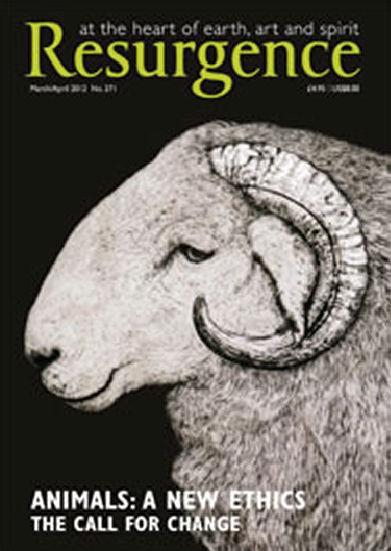
BLAIR’s COMMISSION ON Africa warns that climate change is the “one final factor which will obviously be a major influence on Africa’s future economic growth.” Its weather is becoming more volatile, temperatures are rising, northern and southern latitudes are becoming drier threatening agriculture. And rising sea-levels raise the spectre of floods and loss of low-lying arable land. The Commission argues, amongst other things, that developed countries should therefore “help African countries adapt to the risks of climate change.”
Indeed, climate change changes everything. Its only practicable and equitable solution is the Global Commons Institute’s framework proposal, Contraction and Convergence. This is based on two fundamental principles: first, that global emissions of carbon dioxide must be reduced to an internationally agreed level (contraction); and second, that global governance must be based on justice and fairness, which requires global convergence to equal per capita carbon-emission shares. A key element of the proposal is trading of carbon-emission rights. Carbon-profligate countries will have to buy unused allocations from the more carbon-thrifty ones. As one of the latter, Africa will be rewarded.
However, whatever model of development is proposed, the income from selling carbon-emission rights must go to the people, so as to avoid the risk of it being pilfered by corrupt governments. By these means, the world will be able to look to Africa as a source of huge wealth, one which would be sacrificed by the proposed ‘philanthropic’ intervention.
Blair and the Commission for Africa mistakenly believe that more road building would enable Africa’s economy to prosper. However, reducing transport costs would, as the Commission acknowledges, greatly increase traffic volumes, thereby worsening climate change as well as danger, pollution and other undesirable side-effects of traffic. And Africa would experience some of its most severe impacts.
Climate change turns the world on its head. Contraction and Convergence changes the direction of policy from aid for road building to the transfer of payments to the poor of Africa for their unused carbon rations. This process will enable the African economy to develop, but in a uniquely African way. To “pave paradise and put up a parking lot” along US lines would not be in Africa’s interest because Africa’s carbon revenues would dry up if it did so.
The affluent West can and should repay some of the wealth it has stolen from Africa. Funding for health care, HIV prevention, education and security is urgently needed. But Africa does not need the crumbs from the white man’s carbon banquet to build more roads. As the world’s most carbon-thrifty continent, Africa has massive natural wealth. We must learn from the mistakes of the past and follow the only equitable and effective route by which Africa can prosper.
Roads to Ruin Mayer Hillman and Ian Roberts in Resurgence Magazine
Six workshops May 2011 Sabanci University Istanbul, Turkey
Sabanci Series on Global Civics: How Do We Survive and Prosper in the Global Village?
It has become clear that we live in an increasingly interdependent world. What is less clear is what sort of responsibilities we have towards each other. Without at least a draft of global social contract, it would be impossible for us to navigate our epic global interdependence. Sabanci University, as a world university situated in Istanbul, believes that a university experience in the 21st century has to include a conversation about our responsibilities towards the whole of humanity. As such, Sabanci University has started a series of mini workshops on Global Civics. 2010-11 series consist of six mini-workshops open to the whole of Sabanci University community, including administrators, faculty and students. The series are co-facilitated by Hakan Altinay and Nihat Berker. These workshops take place once a month at Karakoy Communication Center on Fridays between 18:30 and 20:30. Participants are asked to be present at all six events throughout the year, prepare in advance for each workshop, lead the presentation of at least one work during the year, and otherwise actively participate in the discussions. They are also writing a blog after each session. Successful participants will be able to co-author a paper for publication at the end of the Series, and receive a certificate.
- The first session will be on the State of the World. Participants will discuss various theories on globalization, including Richard Nisbett’s The Geography of Thought, Chanda’s Bound Together, The World is Flat by Thomas Friedman, In Defense of Globalization by Jagdish Bhagwati, Globalization and Its Discontents by Joseph Stiglitz, Manifesto for A New World Order by George Monbiot. They will watch Baraka; review UNDP and World Bank statistics on the state of the world; and analyze data from World Values Survey and WorldPublicOpinion.Org.
- The second session will be on the environment. Participants will watch 11th Hour; and review IPCC reports including the 2007 (AR4) Synthesis Report. They will read A Blueprint For A Safer Plant by Nicholas Stern, Storms of My Grandchildren by James Hansen, Earth by Bill McKibben and www.350.org; they will also review Climate Analysis Indicators Tool, created by the World Resource Institute & Contraction & Convergence.
- The third session will be on genocide. The participants will read We Wish to Inform You That Tomorrow We Will be Killed with Our Families by Philip Gourevitch; watch Shaking Hands with the Devil; research the International Criminal Court; and watch The Reckoning.
- The fourth session will be on poverty. The participants will read Never Let me Go; and read Global Problems, Global Solutions by Bjorn Lomborg.
- The fifth session will be on current and proposed schemes to manage global interdependence. The participants will read A Better Globalization by Kemal Dervis, The Great Experiment by Strobe Talbott, Does Fairness Matter in Global Governance by Hakan Altinay, and Global Public Goods. Kemal Dervis or Strobe Talbott will be a guest speaker for this session.
- The sixth session will be a debate about our own responsbilities in an interdependent world. In preparation for the final session, participants will research Vasudhaiva Kutumbakam, Ubuntu and global civics. They will watch an episode of Seinfeld and read Life is not Fair by Bill Barnard. For a plurality of perspectives, they will also watch The Lives Others and Pay it Forward. Video conferencing with other universities with similar predispositions and activities may be organized. After this session, participants will either co-author Global Civics 2.0 or contribute to a collection titled Letters to 7 Billionth Person. Successful participants will receive a certificate.

CONTRACTION AND CONVERGENCE -
An exemplary global framework
‘Contraction and Convergence’ is a strategy aimed at capping and then reducing carbon dioxide emissions (contraction) and by giving an equal entitlement of the capped carbon to every adult, ensuring that all get fair shares of this capped global carbon allocation (convergence). The first step entails calculating and setting a ‘global carbon budget’, the amount of carbon that can be produced each year. The amount will depend on the atmospheric concentration of carbon dioxide that global partners are prepared to countenance. This budgeted amount would then be allocated as carbon entitlements on a per capita basis. The global carbon budget is then progressively reduced until the amount we are entitled to emit equals the globe’s carrying capacity—estimated to be about 12 billion tonnes of carbon dioxide per year. Given the present global population, the amount to which we will ultimately be entitled is about two tonnes per person per year, an amount four times greater than the emission of the average inhabitant of Africa, but five times less than is currently emitted by the average citizen of the UK.
Climate change, poverty and war

“So the only other option requires us to make deeper cuts in our emissions in order to allow developing countries some room to expand theirs. If we divided up the total allowance of 10 billion tonnes equally between the 7 billion people in the world that would give us a new target of 1.5 tonnes each – just 1,500 carbos. This requires that we reduce our emissions by 87% by 2050, and if the world population keeps increasing, by even more. This proposal called Contraction and Convergence has many powerful supporters. Like them I believe it is the only just and politically feasible option.”
Carbon Detox
George Marshall

"Globally Australians now have to look at their own individual hyper-mobility, and the policies of governments that encourage it through subsidies to car ownership and use, and the vast sums annually put into building motorways. The moral challenge is that, on the one hand we must regard every person in the world as having equal rights. So an Australian deserves no less fossil-fuelled mobility and no more than a Chinese or Indian. On the other hand, the limited capacity of the global atmospheric sink means that there must be both a contraction of total global carbon emissions, and a convergence of national emissions to a more equal apportionment of the right to pollute.
Contraction and convergence is the only moral course of action. The alternative is immoral and may one day be criminal.
To avoid irreversible climate change the total proportion of carbon in the atmosphere must not rise to more than 400 parts per million. It has already exceeded 380 ppm. Under a contract and converge scenario, Australian emissions must converge to the global average. Since the global average emissions stood at 4.38 tonnes per capita in 2007, this means at least a four-fold reduction of emissions – one-quarter the present level. But the global average must also be reduced about four-fold; so Australian emissions must be reduced sixteen-fold: that is to one-sixteenth of the present level."
How we move around is a global issue.
Nicholas Low in the Brisbane Times

"An approach that is receiving significant attention, and endorsed by the German Advisory Council on Global Change, is some form of contraction and convergence whereby total global emissions are reduced (i.e., contraction) to meet a specific agreed target, and the per capita emissions of industrialized and the developing countries converge over a suitably long time period, with the rate and magnitude of contraction and convergence being determined through the UNFCCC negotiating process. "Contraction and Convergence” (C&C). C&C is a science-based global climate-policy framework proposed by the Global Commons Institute (GCI) with the objective of realizing "safe”13 and stable greenhouse gas concentrations in the atmosphere. It applies principles of precaution and equity, principles identified as important in the UNFCCC but not defined, to provide the formal calculating basis of the C&C framework that proposes:
- A full-term contraction budget for global emissions consistent with stabilizing atmospheric concentrations of greenhouse gases at a pre-agreed concentration maximum deemed to be “safe” using IPCC WG1 carbon cycle modelling.
- The international sharing of this budget as ‘entitlements’ results from a negotiable rate of linear convergence to equal shares per person globally by an agreed date within the timeline of the full-term contraction/concentration agreement.
- Negotiations for this within the UNFCCC could occur principally between regions of the world, leaving negotiations between countries primarily within their respective regions, such as the European Union, the Africa Union, the US, etc, comparable to the current EU bubble.
- The inter-regional, inter-national and intra-national tradability of these entitlements should be encouraged to reduce costs.
- Scientific understanding of the relationship between an emissions-free economy and concentrations develops, so rates of C&C can evolve under periodic revision."
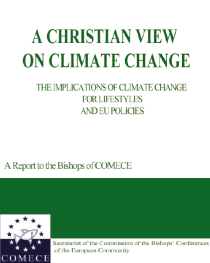
Aspiration for global justice - a bias in favour of the weakest
The aspiration for global justice and special attention for the poor and for those generations who are not yet born are core values of Catholic social teaching.
The contraction and convergence approach to the reduction of greenhouse gas emissions is one option for achieving more global justice through an emission allotment and trading scheme, and a minimum requirement in the light of these values. Contraction relates to the need to reduce the total amount of anthropogenic emissions in order to protect the climate. Convergence relates to the distribution of these outputs. In order to achieve an equitable allocation of emission rights, it is often suggested that each human being in the world should gradually receive the same emission rights: based on their current per capita emissions, fewer emission rights will gradually be allocated to the industrial countries, while the developing countries will increasingly be granted more emission rights until each country achieves the same per ca pita rights by 2050. However, the industrial countries do not necessarily have to achieve all of the emission reductions which have been imposed on them within their own economies: they may also buy emission rights from developing countries, since many emissions in developing countries can be reduced at lower costs than in developed countries.
At a first glance, the principles of contraction and convergence would therefore be consistent with the idea of global justice and with special attention to the poorest. However, it ignores the fact that the atmosphere has been freely used since the beginning of industrialisation, especially in Europe and the USA The already accumulated carbon debt is therefore not taken into account as only future emissions will be equally distribute d among all the nations. The contraction and convergence approach would therefore represent only the absolute minimum in equity terms.
A Christian View of Climate Change
A Report to the Bishops of
COMECE
GCI has written to COMECE about this caveat - imposing 2050 as convergence date and then saying C&C represents the absolute minimum in equity terms - complaining about COMECE recycling ignorant third party opinion [Fischler et al].
This has been met with inquisatorial indifference, so GCI has written about this unwelcome and unhelpful attitude to the Secretary of State at the Vatican.
C&C does not 'dictate' this convergence rate, as this recent memo to the UNFCCC makes clear once again

Accelerated Convergence
KEY MESSAGE to UNFCCC on negotiating Equitable Access to Global Commons Atmosphere
Regarding Decisions at COP-17 for ‘increased ambition’ equals 'accelerated convergence'. Negotiating UNFCCC-compliance globally, *Accelerating the rate of Convergence relative to the rate of Contraction* provides *the Main International Equity Lever.*“C&C has the virtue of simplicity. Equal per capita emissions is a natural focal point. Contestable computations based on economic variables do not need to enter the allocation formula.”
Review of Climate Change Economics to the Australian Government by Ross Garnaut - 2008
“Since the principle of ‘contraction and convergence’ was first proposed by the Global Commons Institute in 2000, it has been widely embraced by some industrialised countries. Under contraction and convergence, each country will start out with emission entitlements equal to its current real emissions levels, and then, over time, converge to equal its per capita entitlements, while the overall global budget contracts to accommodate the emissions reduction objective. The convergence principle should be applied immediately rather than later as the ‘converged point’ in the future. ‘Real emissions’ is a different concept to ‘emissions entitlement’. A country’s high/low per capita real emissions cannot justify its high/low emission entitlements. In the process of convergence, the rights and interests of country B are really infringed by country A. In the National Emissions Account-based solution, the concept of convergence can still be incorporated, but it now merely means ‘convergence of real emissions’ rather than ‘convergence of emission entitlements’. Each country’s gaps between its emission entitlements and real emissions need to be balanced by the traded emissions quotas.”
Development Research Council to the Chinese Government - 2009
“We believe that it is difficult to imagine a global deal which allows the developed countries to have emissions per capita which are significantly above a sustainable global average.”
UK Government’s ‘Committee to the Climate Change Act’
KEY MESSAGE to UNFCCC on negotiating Equitable Access to Global Commons Atmosphere

Reducing per capita differences, while concurrently addressing the environmental implications of the total global emissions - through the fixed global emissions budget - the contraction and convergence approach is arguably both equitable and sustainable. Achieving both objectives, while marginalising neither, is of course the untimate goal. Nevertheless, even with approaches such as contraction and convergence where this appears theoreticaly attainable. Supporters of the approach would argue that contraction and convergence is underpinned by an underlying philosophy based on respect for universal human rights.
International Law
Duncan French
Considerable body of literature concerned with C&C in environmental law emerging here
Report to the United Nations for the 2012 Rio+20 Conference
as part of the Sustainable Development in the 21st Century project
implemented by the Division for Sustainable Development of the
United Nations Department of Economic and Social Affairs
Draft March 4, 2012
Building a Sustainable and Desirable
Implications of systematic caps on natural resources
A lasting prosperity requires a much closer attention to the ecological limits of economic activity. Identifying and imposing strict resource and emission caps is vital for a sustainable economy. The contraction and convergence model developed for climate-related emissions should be applied more generally.
Declining caps on throughput should be established for all non-renewable resources. Sustainable yields should be identified for renewable resources. Limits should be established for per capita emissions and wastes. Effective mechanisms for imposing caps on these material flows should be set in place. Once established, these limits need to be built into the macro-economic frameworks.
Robert Costanza, Carol Franco, Ida Kubiszewski
Institute for Sustainable Solutions,
Portland State University
Gar Alperovitz
The Democracy Collaborative & Department of Government & Politics,
University of Maryland
Herman Daly
School of Public Affairs,
University of Maryland
Joshua Farley
Department of Community Development & Applied Economics,
& Gund Institute for Ecological Economics, University of Vermont
Tim Jackson
Sustainable Lifestyles Research Group,
University of Surrey, UK
Juliet Schor
Department of Sociology,
Boston College
Peter Victor
Faculty of Environmental Studies,
York University, Canada
Ronald Colman
Genuine Progress Index Atlantic,
Nova Scotia, Canada

The Objective of the Climate Convention is largely concerned with factors associated with the requirement for sustainable development. In Chapter 9, four principles were enunciated that should be at the basis of negotiations concerned with future emissions reductions to mitigate climate change.
- The Principle of Sustainable Development.
- The Precautionary Principle,
- The Polluter-Pays Principle and
- The Principle of Equity.
The 'Contraction and Convergence' proposal addresses all of the four principles mentioned above. In particular through its equal per capita sharing arrangements it addresses head-on the question of international equity – and the proposed trading arrangements ensure that the greatest 'polluters' pay. The value of the proposal is that it clearly suggest s some of the principal ingredients of a long-term solution. However, the discussions taking place at the moment and the other proposals that have been put forward35 demonstrate that any international agreement is bound to be more elaborate and to differentiate appropriately between countries. In particular it will have to take account, not just of very large differences between countries in their emissions but also of large differences in the threat of damage from climate change the requirement for adaptation and in their needs and responsibilities especially within the energy sector. Substantial complications arise in these negotiations because of international entanglement of responsibility for greenhouse gas emissions. This is well illustrated by looking at the component of emissions that may be embedded in a country's exports. For instance in 2005, 44% of China's CO2 emissions were embedded in exports of goods and services mainly to Europe, north America and Australia.l5 Other complications arise in the allocation of responsibility for emissions from international aviation, a sector where emissions are rising rapidly.
Global Warming; Complete Guide
J Houghton on C&C

Viable Framework needed to make Growing Demand for Sustainability Successful
Commission on Sustainable Development told UN Economic and Social Council needed
Ms. FISCHER-KOWALSKI said that every year, more resources were consumed through the use of more energy from fossil fuels, which in turn had exhausted the natural-resource base. Global resource consumption was driven by population growth, rising incomes, and increasing development. Growing population numbers were the strongest drivers as the numbers had increased substantially and consumption per capita remained high, she said, adding that rising income was not as much of a threat to consumption levels. A decoupling effect had taken effect over the years in which per capita resource materials had grown faster than income per capita. In addition, energy use had slowed down in relation to income, she said, noting that development was the least harmful of the driving factors as it could actually relieve consumption tensions in some cases.
Calling attention to the internationally unequal distribution of resources, she said corporate control of resources was a major concern which had led to unequal consumption rates and an externalization of environmental costs, since resources from the developing world were often used in developed countries. The consumption of natural resources -- including industrial and construction materials, fossil energy and biomass -- had “exploded” to between 18 to 60 billion tons over the last 100 years, she noted. Industrialized countries had begun to stabilize their high consumption levels while developing countries were steadily increasing theirs. She pointed out that two thirds of the world’s population lived in countries with low consumption rates by population and development, specifically India and China.
In efforts to foresee the consequences of continuing current consumption trends in the next 50 years, she shared three scenarios: freeze and catch up; moderate contraction and convergence; and tough contraction and convergence. The first scenario -- in which industrialized countries maintained current consumption rates while developing countries caught up -- would cause a doubling of resource consumption rates per capita. The second would involve industrialized countries reducing their consumption while developing countries caught up, a method more in line with any moderate climate-protection strategy. However, the third scenario, in which countries did not increase annual consumption rates, was nearly implausible as it would impose tough constraints, she said. To achieve sustainable resource consumption, a new transition focused on sustaining human well-being and development was necessary, she said, emphasizing that the key was maintaining development while consuming less.
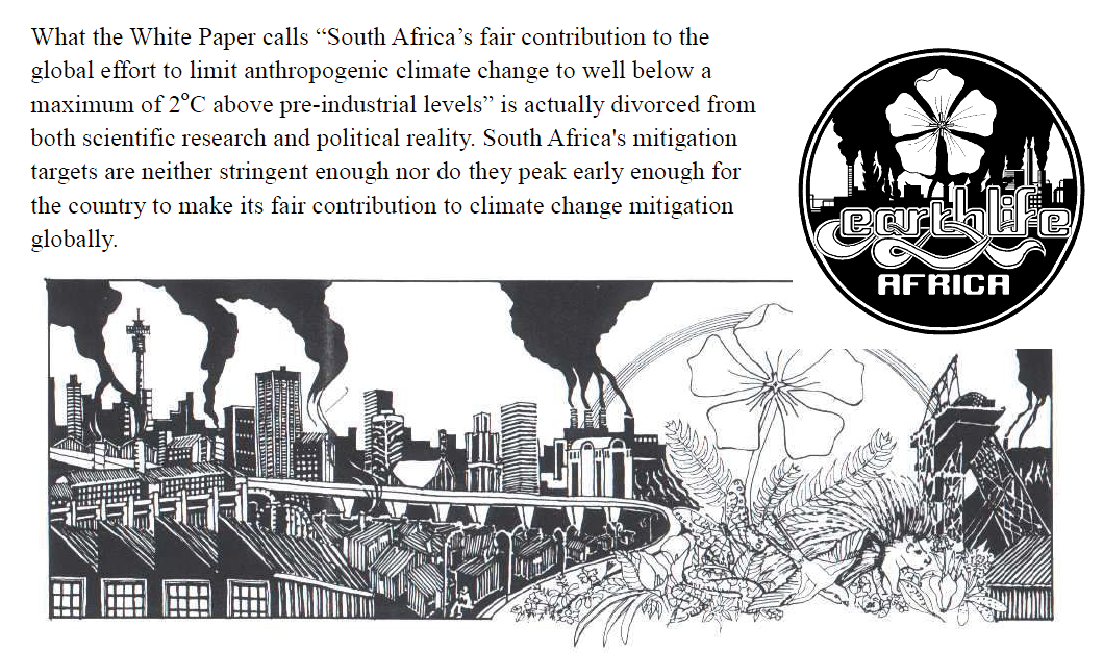
What the White Paper calls “South Africa’s fair contribution to the global effort to limit anthropogenic climate change to well below a maximum of 2 degrees Celsius above pre-industrial levels” is actually divorced from both scientific and political reality. South Africa’s mitigation targets are neither stringent enough nor do they peak early enough for the country to make its fair contribution to climate mitigation globally.
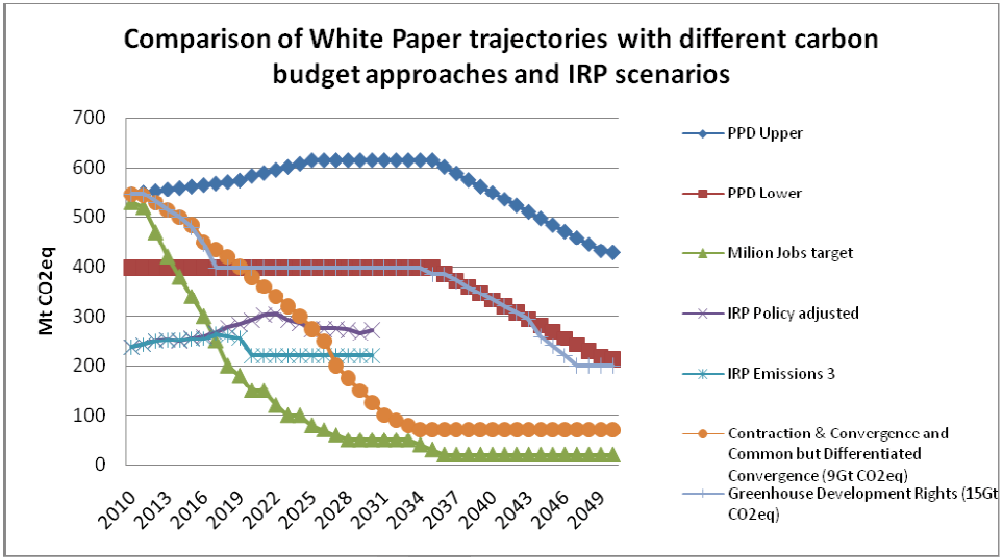
The graph on page 9 [shown above] contains the DEA figures for the upper range of the peak, plateau and decline trajectory, as well as the lower range. It also contains the Integrated Resource Plan (South Africa’s electricity build plan) emissions numbers from the Department of Energy which illustrate how the chosen policy (policy-adjusted) compares against the discarded Emissions 3 scenario (these lines only go to 2030 as the IRP is only a 20 year plan). They do illustrate, however, how recent electricity build plans will have emissions (which are currently about 50% of South Africa’s emissions) into the future that far exceed what SA should be aiming for if it were to take a per capita, contraction and convergence, or even a GDRs approach. Only the discarded Emissions 3 scenario is roughly in line with the PPD lower trajectory or a GDRs approach; the chosen policy-adjusted approach will result in South Africa overshooting its fair share allocation of a 2 degrees C budget.
Sustainable Energy Briefing 23: EARTHLIFE AFRICA South Africa’s Mitigation Targets


MSI Seminar
Penetrating analysis of sustainability over time. It takes in
life-expectancy and per capita consumption differentials globally.
A global carbon target using human life expectancy
Paul Read - Monash Sustainability Institute and Faculty of Medicine, Nursing and Health Sciences

